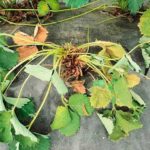Dutch breeders gave the world not only a huge number of varieties of tulips, but also elite varieties of berries. The purpose of the development of new hybrids was to develop varieties suitable for industrial cultivation, with a pronounced taste, dense structure, which would allow the delivery of fruits without loss of presentation. All these qualities have a strawberry sonata.
Table of contents
Description strawberry variety sonata
The variety was bred by Dutch breeders, refers to the mid-early maturation. From the progenitors, the hybrid received a good yield - 1-1,5 kg from a bush, resistance to diseases and the ability to adapt to different environmental conditions.
Small leafy shrub of small size with upright dark green leaves and wrinkled surface. Powerful flower stalks, easily holding a large berry, reach the level of foliage or grow above it.
The fruiting period begins in June, mainly in the second half. Duration of fruiting is 4-6 weeks. Without a transplant, a crop has been grown for more than 5 years without loss of yield.
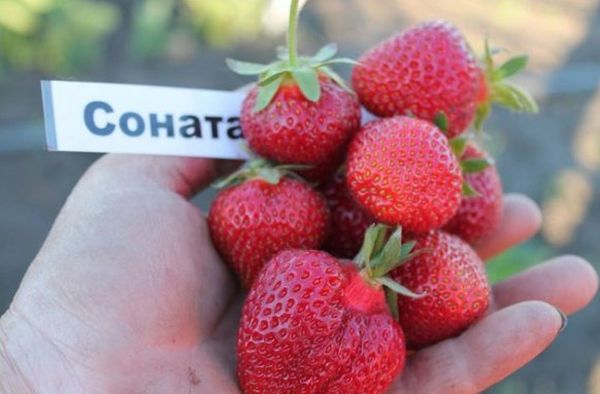
Sonata ideal for industrial and home growing. It also develops and bears fruit equally well in open beds and in greenhouses.This is due to the simplicity of the plant and frost resistance.
It is preferable to cultivate the culture in temperate climates. When creating heat protection from agrotextiles, strawberries can be grown even in the Northern part of Europe.
Characteristics of berries
The shape of the berries is wide-conical, similar to the heart. The fruit is red with a characteristic luster has a dense structure, delicate pink flesh. It tastes sweet, juicy with a light shade of sourness. In diameter strawberry reaches 35 mm (40-50 grams).
More than 70% yield corresponds to the standard indicators, which indicates the commercial availability and a small number of deformed berries. Even with heavy rains retains a holistic look, unlike other varieties that burst from the abundance of moisture.
The process of collecting and transporting does not spoil the external qualities of the fruit. The fresh look of the sonata retains quite a long time.
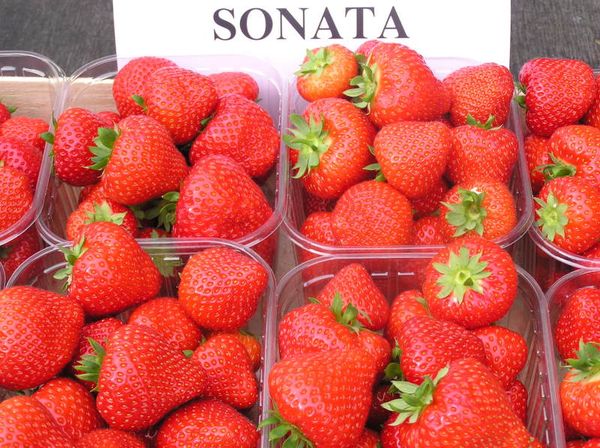
Breeding history and region of growth
The sonata was bred by the breeders from Holland in 1990 by crossing two varieties - Elsanta and Polk. The company Fresh Forward is the copyright holder of the received hybrid and carries out license supervision.
The creators took care of versatility, endowing strawberries with the ability to bear fruit both in the open field and in greenhouses. The plant adapts to almost any conditions, which makes it possible to grow berries in regions with different climatic features.
it one of the most successful projects Dutch breeders. No wonder their technologies are considered successful, ideal for industrial applications.
The advantages and disadvantages of the variety
The sonata variety is characterized by the following primary qualities:
- compactness of the bush;
- resistance to many diseases;
- frost resistance;
- unpretentiousnessdue to adaptability;
- a long period of fruiting (from the second half of June to August);
- a dense structure that allows you to collect and transport without reducing the presentation;
- suitability for industrial and dessert cultivation;
- high yield.

Not without sonata and flaws:
- weak mustache formation;
- low resistance to verticillosis;
- with increased humidity, heart or root rot develops;
- needs in enhanced fertilizer and the balance of injected trace elements.
Planting seedlings
Selected seedlings should have 4-5 leaves, on which there are no stains or deposits, color - smooth, elastic skin. A sign of good quality is a thick horn (not less than 0.7-0.8 cm).
It is necessary to refuse a sluggish sprout, having given preference to fresh with a fibrous form of roots more than 7 cm long. According to reviews of experienced gardeners, seedlings grown according to the technology of freego have recommended themselves well.
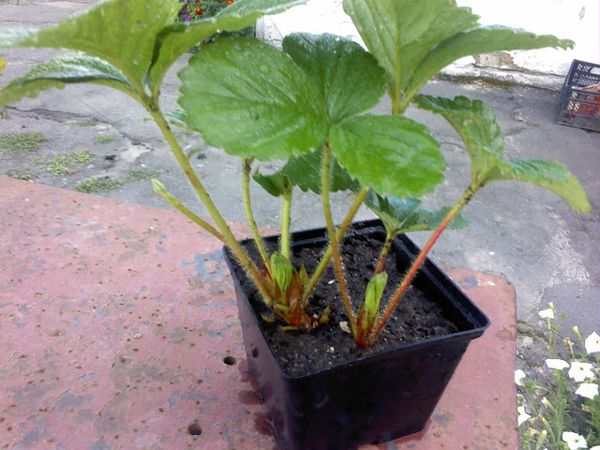
To create beds suitable sunny plot. Ideally, it should be protected from winds by tall trees or bushes growing nearby.
High groundwater levels or the location of a vegetable garden in a lowland can cause root rot or fungal infections. Therefore, a place on a hill would be preferable.
Soil before planting cleared of weeds and debris. Weeding should be carried out carefully, removing the roots deeply embedded into the soil. This procedure will facilitate the care of strawberries in the process of its growth and especially fruiting.
Sonata loves light subacid, and most importantly fertile soil.
Determine the degree of nutritional value can be growing on the site of plants:
- white clover lives on poor soil;
- nettle and woodlouse indicate the presence of nitrogen, which eliminates the entry of nitrogen fertilizers;
- coltsfoot, horsetail, horse sorrel grow on heavy soil, which means that it should be diluted with sand.
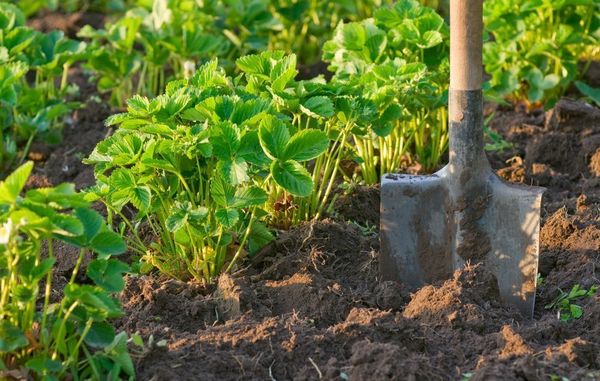
Enrich the area with nutrients better compost or rotted manure. This should be done six months before disembarking (in the fall, if you plan to land in the spring) or 2 weeks before spring work. Siderats are used for disinfection.
Disembarking is recommended in July or early spring. Distance between tubers - 25-30 cm. The July seedlings will have time to adapt to a new place, to form buds,which will ensure yields next season.
The spring option also has favorable conditions for the vegetative process. The worst time to disembark is late summer and autumn. The plant will barely have time to adapt, but it does not gain strength for wintering.
Growing conditions
Watering
After planting seedlings plant requires abundant watering. After adaptation, the amount of water decreases.
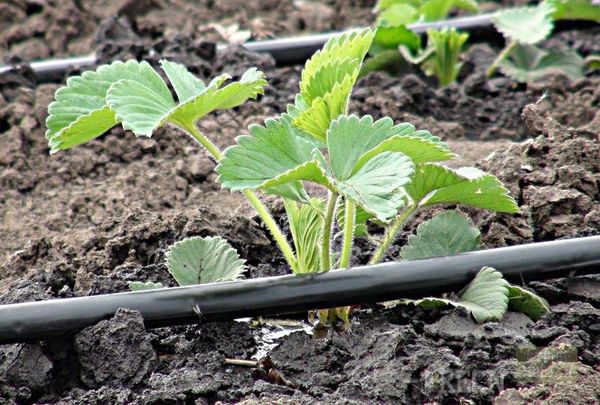
Irrigation is done before the end of September, strawberries need to gain strength before winter. Spring watering is characterized by high intensity during the flowering period and a decrease at the beginning of fruiting (the minimum rate is 7 liters per 1 m2). In any case, it is necessary to control the condition of the soil to avoid excessive moisture.
It is preferable to use a rain irrigation method or drip system.
Fertilizer
Variety Sonata demanding fertilizer composition. Used bait should contain magnesium, manganese, iron, and other trace elements.
In the spring it is important to use nitrogen-containing fertilizers, stimulating the development of the bush.Before the beginning of the flowering period, the soil can be treated with an Azofos plant by spreading a couple of tablespoons in a bucket of water. Consumption rate of solution 1 liter.
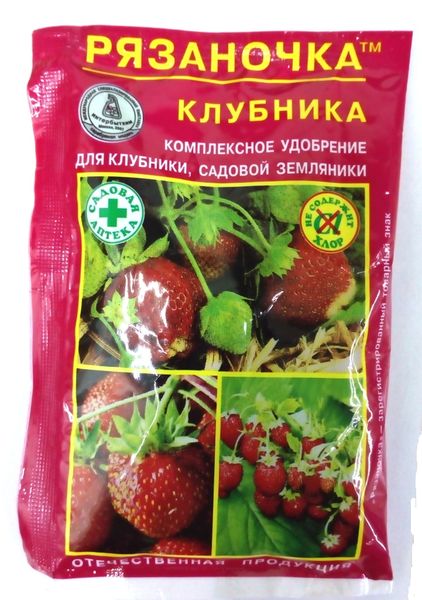
To increase the yield It is recommended to spray the bushes with a solution prepared on the basis of a bucket of water and in 5 ml formulations: Ryazanochka, Sudarushka.
Preparing for the winter
In August, the bushes it is necessary to cut and clean the beds from weeds and debris. In September, the soil is enriched with rotten manure or mineral fertilizers. In late September - early October, the beds are covered with a layer (5 cm) of straw or agrofibre.
Under favorable conditions, the tubers planted in July will begin to bear fruit the following year. If the seedlings did not have time to acquire buds, it will be possible to harvest in a season.
Diseases and pests
The strawberry sonata is less susceptible to powdery mildewthan other varieties. However, weak points are heart and root rot. Also plant sensitive to verticillosis.
- Sonata fairly resistant to powdery mildew
- But very susceptible to verticillosis
Timely prevention can help avoid problems:
- planting bushes at a fixed distance, avoiding thickened beds;
- cleaning strawberries from damaged leaves and twigs;
- rejuvenation;
- avoiding the use of fresh manure;
- treating the roots of seedlings before planting with a weak solution of potassium permanganate;
- Prevent soil drying and waterlogging.
When detecting verticillosis, it is necessary to treat the bushes with special preparations. For example, Benorado, Fundazol. Spraying with Fundazol, Teldor, Bayleton or other means will help stop the damage to plants with gray rot.
To get rid of root rot (rhizoctonia) can only be preventive measures, so the preparatory procedure should not be ignored.
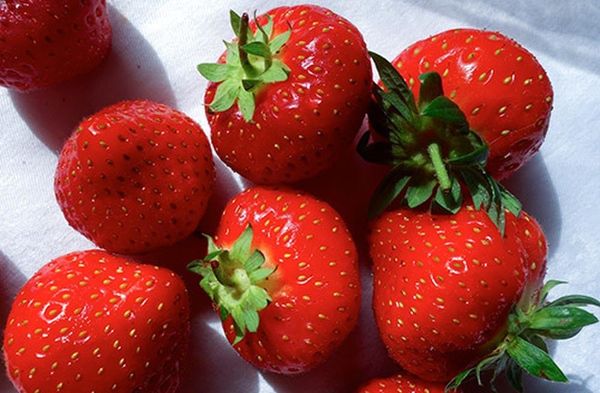
Growing strawberries is fun and very enjoyable, especially when you manage to get a generous harvest. With a variety of sonata, this is quite realistic, it is worth putting a little effort in caring for a sweet beauty.


